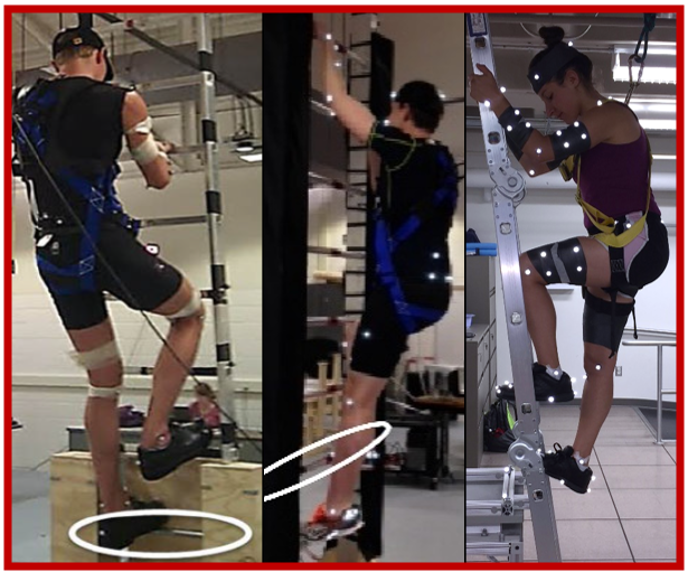Potential Graduate Student Research Projects
Effectiveness of Level Tools and Instruction on Optimal Ladder Setup

Workplace fatalities are more prevalent in construction than other industries. Falls are a leading cause of these accidents, contributing to 36% of fatal construction injuries. Working from heights is a known hazard, but inherent to construction (ladders, roofs, scaffolding). Among these elevated heights, ladders are the leading cause of fatal falls from a height.
The objective of this study is to quantify the barriers of safe ladder setup. Prior ladder safety research has identified the optimal ladder setup to prevent movement of the ladder base – movement that causes a ladder fall. Yet, ladder tipping is still a common cause of ladder falls, particularly in residential construction where safety knowledge and resources are limited. There is a need to isolate the disconnect between recommended ladder setup and users’ performance in achieving the optimal ladder setup.
We are quantifying the effects of level tools, instruction, and ground surface on safe ladder setup. Perceived barriers to safe ladder setup will be extracted from construction workers through observed behaviors and structured interviews. This knowledge is required to eliminate the disconnect between safe ladder setup practices and user performance. Broader impacts from this study will comprise of level tool-specific instructional videos to improve safe ladder setup. These deliverables will be validated from residential construction workers via our outcome measures of ladder setup accuracy and ladder tip risk.
Neural Components of Step Training Efficacy with Active and Inhibitory Information

One in three older adults fall each year. Falls among the older adult population commonly lead to severe injuries and adverse outcomes to the quality of life. Injurious falls are a growing healthcare concern with our aging population. Step training programs are a promising fall prevention intervention, reducing fall rate in older adults. Many but not all individuals benefit from step training interventions. To improve efficacy of step training programs, greater knowledge of the underlying mechanisms associated with improved stepping performance is warranted.
The objective of this study is to quantify the neural components of stepping performance. Neural components of active and inhibitory stepping performance will be captured from mobile brain imaging procedures via electroencephalogram (EEG). This knowledge will guide future step training programs that facilitate activation of neural components associated with fall risk reduction and aid in identifying individuals at increased fall risk.
Perception of Falling Objects with Increased Peripheral Vision

Falling objects are a common source to injury in construction. While safety helmets can mitigate the impact of injury from falling objects, advancements in personal protective equipment (PPE) can improve a worker’s perception of falling objects to aid the worker in making a protective postural adjustment.
The objective of this study is to assess the perception of falling objects with increased peripheral vision. We will investigate perception of falling objects across multiple devices and locations. Knowledge from this study will guide advancements in PPE to improve worker safety.
Electrocortical Dynamics of Sensory Reweighting

Our sensory system regularly updates to our environments. If we enter a dark room, our sensory system will decrease the weighted input from our visual system and increase the weighted input from our other sensory systems (somatosensory, vestibular, auditory) to navigate safely through the dark room. If one or multiple sensory systems become impaired, our ability to safely navigate through our environment is challenged. Behavioral tests are the current standard for assessing the quality of our sensory system but provide limited scope on the mechanisms of impairment. Mobile electroencephalogram (EEG) is a promising method to assess the mechanisms of impairment during sensory reweighting.
The objective of this study is to quantify the electrocortical dynamics of sensory reweighting. We will investigate the electrocortical dynamics across various environment changes known to disrupt our sensory system. Validating the electrocortical dynamics of sensory reweighting will provide critical knowledge to the mobile brain imaging field and improve individual screening assessments of sensory system impairments.
Previous Research Projects
Efficacy of Balance Training with Intermittent Sensory Perturbations in Younger and Older Adults

Balance training paradigms can reduce the financial and paralyzing burden of falls in older adults, but the efficacy of these balance training paradigms is not well understood. This research study is uncovering the sensory integration, computational processes, and motor output responses across four balance training paradigms with intermittent perturbations to a sensory system (visual, somatosensory, auditory, none) between younger and older adults. These results will reveal critical knowledge on balance training efficacy for the aging, falls and neuromechanics fields and is necessary to design interventions of high efficacy to reduce fall injuries in older adults.
In the process of disseminating these results.
Physiological, Cognitive and Behavioral Factors of Domestic Ladder Use in Younger and Older Adults

Ladder Use Ability, Behavior and Exposure by Age and Gender
Correlations between reach, lean and ladder tipping risk
Ladder use in older people: type, frequency, task and predictors of risk behaviours
Individual factors that influence task performance on a straight ladder in older people
Individual factors that influence task performance on a stepladder in older people
Individual, Environmental, and Biomechanical Factors of Ladder Falls

Strategies to Reduce Fall Severity after a Perturbation during Ladder Climbing
Hand-rung force after a ladder climbing perturbation
Characterizing the Shoe-Rung Friction Requirements during Ladder Climbing
Effects of upper body strength, hand placement and foot placement on ladder fall severity
Effects of Ladder Climbing Patterns on Fall Severity
Effects of foot placement, hand positioning, age and climbing biodynamics on ladder slip outcomes
